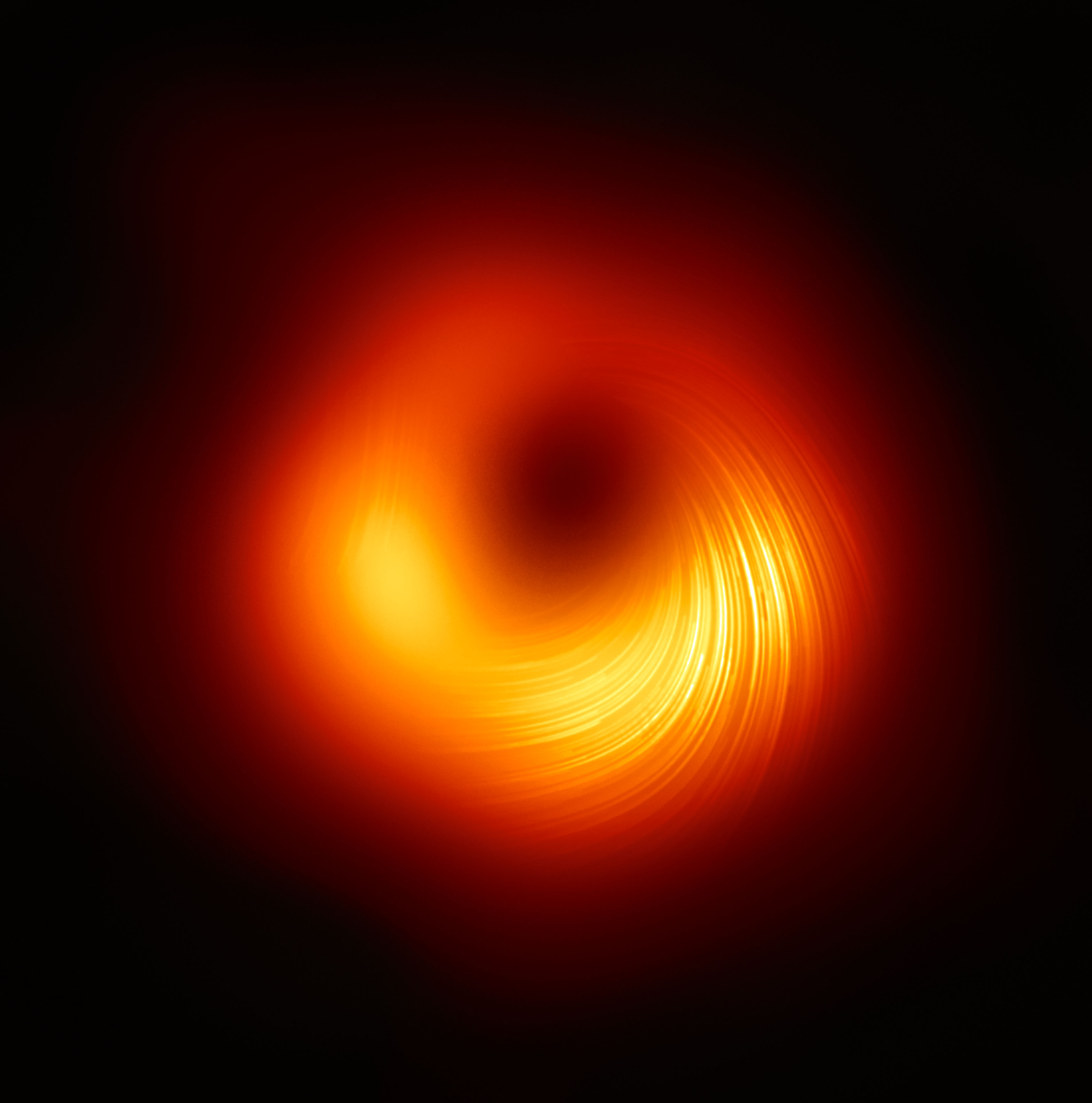News
Astronomers Image Magnetic Fields at the Edge of M87’s Black Hole
The Event Horizon Telescope (EHT) collaboration, who produced the first ever image of a black hole, has revealed today a new view of the massive object at the centre of the M87 galaxy: how it looks in polarised light. This is the first time astronomers have been able to measure polarisation, a signature of magnetic fields, this close to the edge of a black hole. The observations are key to explaining how the M87 galaxy, located 55 million light-years away, is able to launch energetic jets from its core.
 |
| A view of the M87 supermassive black hole in polarised light. The curved lines mark the orientation of polarisation, which is related to the magnetic field around the shadow of the black hole. © EHT Collaboration |
“We are now seeing the next crucial piece of evidence to understand how magnetic fields behave around black holes, and how activity in this very compact region of space can drive powerful jets that extend far beyond the galaxy,” says Monika Mościbrodzka, Coordinator of the EHT Polarimetry Working Group and Assistant Professor at Radboud University in the Netherlands.
On 10 April 2019, scientists released the first ever image of a black hole, revealing a bright ring-like structure with a dark central region — the black hole’s shadow. Since then, the EHT collaboration has delved deeper into the data collected in 2017. They have discovered that a significant fraction of the light around the M87 black hole is polarised.
“This work is a major milestone: the polarisation of light carries information that allows us to better understand the physics behind the image we saw in April 2019, which was not possible before,” explains Iván Martí-Vidal, also Coordinator of the EHT Polarimetry Working Group and GenT Distinguished Researcher at the University of Valencia, Spain. He adds that “unveiling this new polarised-light image required years of work due to the complex techniques involved in obtaining and analysing the data.”
Light becomes polarised when it goes through certain filters, like the lenses of polarised sunglasses, or when it is emitted in hot regions of space that are magnetised. In the same way polarised sunglasses help us see better by reducing reflections and glare from bright surfaces, astronomers can sharpen their vision of the region around the black hole by looking at how the light originating from there is polarised. Specifically, polarisation allows astronomers to map the magnetic field lines present at the inner edge of the black hole.
“The newly published polarised images are key to understanding how the magnetic field allows the black hole to 'eat' matter and launch powerful jets,” says EHT collaboration member Andrew Chael, a NASA Hubble Fellow at the Princeton Center for Theoretical Science and the Princeton Gravity Initiative in the US.
The bright jets of energy and matter that emerge from M87’s core and extend at least 5000 light-years from its centre are one of the galaxy’s most mysterious and energetic features. Most matter lying close to the edge of a black hole falls in. However, some of the surrounding particles escape moments before capture and are blown far out into space in the form of jets.
Astronomers have relied on different models of how matter behaves near the black hole to better understand this process. But they still don’t know exactly how jets larger than the galaxy are launched from its central region, which is as small in size as the Solar System, nor how exactly matter falls into the black hole. With the new EHT image of the black hole and its shadow in polarised light, astronomers managed for the first time to look into the region just outside the black hole where this interplay between matter flowing in and being ejected out is happening.
.jpg) |
| The IRAM 30-meter telescope near Granada (south of Spain) is the most sensitive single telescope of the EHT array. Credit: DiVertiCimes |
The observations provide new information about the structure of the magnetic fields just outside the black hole. The team found that only theoretical models featuring strongly magnetised gas can explain what they are seeing at the event horizon.
“The observations suggest that the magnetic fields at the black hole’s edge are strong enough to push back on the hot gas and help it resist gravity’s pull. Only the gas that slips through the field can spiral inwards to the event horizon,” explains Jason Dexter, Assistant Professor at the University of Colorado Boulder, US, and coordinator of the EHT Theory Working Group.
To observe the heart of the M87 galaxy, the collaboration linked eight telescopes around the world, including the IRAM 30-meter telescope in the Spanish Sierra Nevada, financed by the French CNRS, the German Max-Planck-Gesellschaft and the Spanish Instituto Geografico Nacional, to create a virtual Earth-sized telescope, the EHT. The impressive resolution obtained with the EHT is equivalent to that needed to measure the length of a credit card on the surface of the Moon.
This allowed the team to directly observe the black hole shadow and the ring of light around it, with the new polarised-light image clearly showing that the ring is magnetised. The results are published today in two separate papers in The Astrophysical Journal Letters by the EHT collaboration. The research involved over 300 researchers from multiple organisations and universities worldwide.
In April 2021, the EHT launches its next global observing campaign, including IRAM’s second facility, the NOEMA observatory, a highly sensitive antenna array in the French Alps. "With the deployment of NOEMA in April 2021 the imaging and sensitivity capabilities of the EHT will take another dramatic leap forward. Together with the 30-meter telescope, IRAM facilities will thus play a key role in the EHT in unlocking new, previously inaccessible and probably unexpected insights into the physics at the edge of black holes", concludes IRAM Director, Karl Schuster.
Notes
The EHT collaboration involves more than 300 researchers from Africa, Asia, Europe, North and South America. The international collaboration is working to capture the most detailed black hole images ever obtained by creating a virtual Earth-sized telescope. Supported by considerable international investment, the EHT links existing telescopes using novel systems — creating a fundamentally new instrument with the highest angular resolving power that has yet been achieved.
The individual telescopes involved are: ALMA, APEX, the IRAM 30-meter Telescope, the IRAM NOEMA Observatory, the James Clerk Maxwell Telescope (JCMT), the Large Millimeter Telescope (LMT), the Submillimeter Array (SMA), the Submillimeter Telescope (SMT), the South Pole Telescope (SPT), the Kitt Peak Telescope, and the Greenland Telescope (GLT).
The EHT consortium consists of 13 stakeholder institutes: the Academia Sinica Institute of Astronomy and Astrophysics, the University of Arizona, the University of Chicago, the East Asian Observatory, Goethe-Universitaet Frankfurt, Institut de Radioastronomie Millimétrique (CNRS, MPG, IGN), Large Millimeter Telescope, Max Planck Institute for Radio Astronomy, MIT Haystack Observatory, National Astronomical Observatory of Japan, Perimeter Institute for Theoretical Physics, Radboud University and the Smithsonian Astrophysical Observatory.
More information :
Resources :
- EHT
- IRAM YouTube channel
- Virtual Visit of the IRAM telescopes
Bibliography :
First M87 Event Horizon Telescope Results VII: polarization of the ring
First M87 Event Horizon Telescope Results VIII: Magnetic Field Structure Near The Event Horizon
Contacts:
Karl Schuster - IRAM Director - Tel +33 4 76 82 49 08
Frédéric Gueth – IRAM Deputy director – Tel + 33 4 76 82 49 34
Public Outreach Contact:
IRAM : Karin Zacher - Tel +33 4 76 82 21 03 - Press Information

